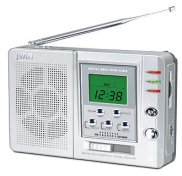
Small Radio With Features
This is an attractive little package with good sensitivity as well as good sound, especially for voice reception. Along with AM (MW) and FM, it has 7 shortwave bands. All buttons are raised. Its heavy duty telescopic antenna pivots.
The easy-to-read LCD display is digital, but it has knob tuning. The frequency readout is accurate, according to several known stations I'd checked on several bands. Apparently the display is that of a true frequency counter.
It has a 12-hour a.m./p.m. clock with an alarm. Its three LEDs are for Tune, AM (MW and SW), and FM. On its back is a flip out easel and the serial number.
It has a jack for earphones. (Earbuds are not supplied.) Although the jack's audio output on FM is monaural, it is dual (split) in all modes. To make sure, I compared it with the stereo FM output of my eTraveller VII. I tuned both radios to one of my area's two classical FM stations. While a symphony was being played, I switched my stereo headphones between the two.
The power supply is two AA cells. It has a jack for an external 3 volt source. (AA cells and wall adapter are not supplied.)
There is enough extension past each end of the advertised SW bands to cover the daytime and some nighttime U.S. frequencies, but there is no coverage at all for some of the nighttime ones. Although there are slight differences for a given radio, the actual band stop-to-stop coverage of mine is:
Bands
SW1 5.84 --- 6.47 MHz
SW2 6.86 --- 7.56 MHz
SW3 9.29 - 10.30 MHz
SW4 11.38 - 12.50 MHz
SW5 13.34 - 14.35 MHz
SW6 14.78 - 15.84 MHz
SW7 17.11 - 18.33 MHz
AM 518 - 1723 kHz
FM 87.9 - 107.9 MHz
Shortcomings
There are a couple of little shortcomings. One is when two stations of unequal signal strength are within 15 to 20 kHz of each other, the stronger station wins. The reason is that the stronger station will "pull" the receiver's local oscillator. This is due to the lack of a tunable input where the real selectivity of a receiver begins. I learned of this when I tried to receive a good signal on 12.172 MHz. I'd tune in to it but a louder 12.160 signal would pull it off. (I settled for a good, clear simulcast on 9.330.)
This problem created a phenomenon, too. When I tuned in WWV's 10.00 MHz time signal, during when third world stations were transmitting on or just below that frequency, the display would read 10.01 MHz.
The other shortcoming is that I noticed the clock seemed to have lost about a minute within a week or two. I'll take another look at that. (This, of course, will affect its alarm clock feature, too.) My advice, if that happens in any unit, is to reset the time once a week, and set it ahead enough, so station
sign-ons won't be missed during the week.
One little nuisance is that it defaults to FM at turn on. That's not a problem, though, because it remembers the last FM, AM, or SW frequency selected. Just push the AM button to get back to your chosen SW frequency, for example.
This would make a fine, inexpensive gift for anyone who is really interested in knowing what's going on in the world, or to enlighten those who should -- or think they do. They should, though, also be given some SWL introductory material as well as help in identifying, even finding, major SW stations (guides, schedules, Web links, etc.)
The jWIN is about the size of a paperback book, but a little shorter. My bulky wallet is almost as big. When it's not in use, I keep it and its paperwork in a ZipLoc sandwich bag.
I purchased my jWIN from Johnson Smith Co. Click on Electronics and look for the Mini 9 Band Radio. This place has the best price. And its service is good. I've bought a variety of things from them.
Note: For my grandson and a girl next door, I ordered two jWINs, S/Ns 030404343 and 030404379. Their performance was like mine, i.e., as above.